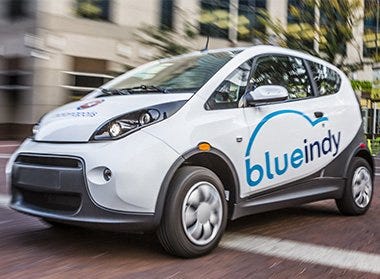The electric-car sharing future has got the blues.
BlueIndy, a pioneering car-sharing service in Indianapolis that launched in 2014, quietly closed last month. Beset by losses, the decision to pull the plug on BlueIndy’s electric cars came before the global coronavirus pandemic – and as other similar services have also shut their doors.
Now the post-pandemic landscape is creating more uncertainty for the nascent industry as the public pulls back from the idea of sharing potentially contaminated vehicles.
“The challenge is the same for everyone in the mobility space over the years, particularly car-sharing,” said Guidehouse Insight auto analyst Sam Abuelsamid. “It’s a really hard business to make money in. BlueIndy is not the only one to go under. We’ve seen a number of these go out of business over last few months – GM announced they shut Maven down after scaling back last year. And Share Now, that BMW/Daimler venture, announced they were pulling out of North American market.”
Widely hailed when it was introduced in 2014 as the Midwest’s first adoption of green city cars like Europe (BlueIndy featured the same Pininfarina-designed Bollore BlueCars that populate the electric car fleet in Paris), the service never caught on.
In its wake, Blue Indy leaves 250 battery-powered cars, electric-charging structure and recriminations over a city council that spent $7 million on the program without voter approval. Half of the cars have been sent to a scrapyard for dismantling while the other half have reportedly been relocated to Los Angeles for use in a similar car-sharing operation.
Blue Indy made the announcement to close last December, but the service stayed operational through May 21 when current subscriptions ran out.
The program’s cute little EVs were sprinkled throughout Indianapolis and available to rent and return. The service was available for a one-time fee or annual membership. One-time users paid $8 for 20 minutes; an annual membership was $9.99 per month, not including additional charges for more time at the wheel.
The service had hoped to reach 15,000 members, 500 cars and 200 charging stations, but peaked instead at 3,000 members, 250 cars and 92 stations as interest waned after a well-publicized start. France’s Bolore was the primary investor, but the program also received support from Indiana institutions including Indianapolis Power & Light utility, which invested more than $3 million to extend electric lines to the chargers.
Former Indianapolis Mayor Greg Ballard hoped to give to give the Midwest city a progressive feel. Car-sharing and ride-hailing services like Uber have been touted as modern alternatives for less-dense cities without expensive, public-transit rail systems.
“We think it’s the perfect city to do this,” BlueIndy General Manager Scott Prince told the Indianapolis Business Journal in 2014. “If we had the world’s greatest mass-transit system today, this arguably would not be the first city we’d be launching in in America.”
GM’s Maven pulled out of eight of its 17 markets — including Chicago and New York — last year before the COVID-19 outbreak halted the business in its tracks this April. The BMW-Daimler joint venture Share Now was focused on major American and Canadian cities like Seattle, New York and Montreal, but folded its cards late last year.
As BlueIndy indicates, the car-sharing services were struggling before the COVID-19 crisis. The post-pandemic landscape looks even more challenging.
“The concern a lot of people have now, and this applies to car-sharing, ride-sharing — all the transit options — is when you get into one of these vehicles and you don’t know when it was last cleaned,” said analyst Abuelsamid. “There might have been somebody in there 15 minutes before who was sick.”
A survey taken this May by the IBM Institute for Business Value of 25,000 U.S. adults found significant change in attitude toward ride-sharing services, The survey found a shift away from public transit and ride-sharing toward individual transportation.
“More than half of people surveyed who used ride-sharing apps and services said they would either use these less or stop using these services completely,” concluded the IBM study. “More than 17% of people surveyed said that they intend to use their personal vehicle more as a result of COVID-19, with approximately 1 in 4 saying they will use it as their exclusive mode of transportation going forward.”
BlueIndy got mixed reviews from users.
Green advocate Mary Beatty, 65, told the IndyStar she was drawn to BlueIndy becasue of her belief in renewable energy. But they encountered issues when they took the EV to the airport.
“It was so difficult trying to put our luggage in, and we couldn’t figure out how to open the hatch,” she told the newspaper. “The quality of the car was not good and kind of frightening because it is a lightweight car and did not handle well on the highway.”
Abuelsamid said that the cars did not meet federal safety standards, so they could be used in a ride-sharing capacity. Some customers complained of the car’s cheap build. Others complained of poor customer service as well as lack of convenience.
“There was a pretty big learning curve, and it didn’t make it a user-friendly experience, even for someone who was motivated,” said Beatty. “After our membership expired we didn’t renew.”
Henry Payne is auto critic for The Detroit News. Find him at hpayne@detroitnews.com or Twitter @HenryEPayne.
Read or Share this story: https://www.detroitnews.com/story/business/autos/2020/06/09/flop-blueindy-car-share-reflects-broader-ride-hailing-challenges/5329172002/
